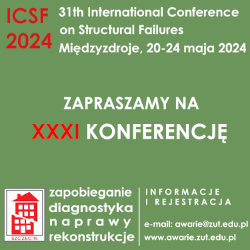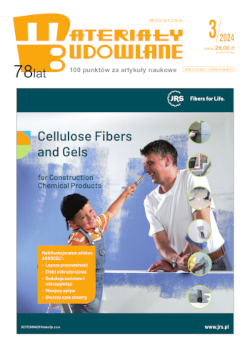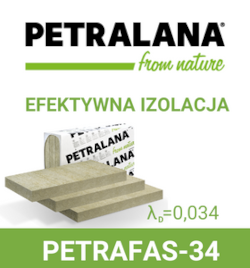mgr inż. Farzam Omidimoaf, University of Qom, Department of Civil Engineering; Iran
prof. dr inż. Ali M. Rajabi, University of Tehran, School of Geology, Engineering Geology Department; Iran
prof. dr inż. Hakim S. Abdelgader, University of Tripoli; Department of Civil Engineering; Libya
dr. inż. Marzena Kurpińska, Gdansk University of Technology, Faculty of Civil and Environmental Engineering, Poland
prof. dr hab. inż. Krzysztof Wilde, Gdansk University of Technology, Faculty of Civil and Environmental Engineering, Poland
Adres do korespondencji: Ten adres pocztowy jest chroniony przed spamowaniem. Aby go zobaczyć, konieczne jest włączenie w przeglądarce obsługi JavaScript.
DOI: 10.15199/33.2019.03.01
artykuł naukowy
Two-stage concrete (TSC) is a special type of concrete that themethod of its construction and implementation is different fromconventional one. In TSC, coarse aggregate particles are first placed in the formwork and voids between themare subsequently injected with a special cementations mixture. TSC has been successfully used in many applications, such as underwater construction, casting concrete sections congested with reinforcement and concrete repair. Coarse aggregate forms about 60% of the total volume of TSC, while coarse aggregate forms about 40% of the total volume of conventional concrete. In TSC stresses are transferred through contact areas between coarse aggregate particles. In this paper coarse aggregate size influence on strength parameters of TSC and comparing it with conventional concrete is done (by uniaxial compressive strength test and Brazilian tensile strength test). According to results of tests in this paper, the TSC with finest grain of coarse aggregate has higher compressive and tensile strength, higher modulus of elasticity and less Poisson’s ratio from conventional concrete.
Keywords: two-stage concrete; conventional concrete; uniaxial compressive strength; tensile strength; modulus of elasticity.
Wpływ kruszywa gruboziarnistego na parametry wytrzymałościowe betonu dwuetapowego
Beton wykonywany dwuetapowo (TSC) jest specjalnym rodzajem betonu, a jego metoda wbudowania i zastosowanie różnią się od tradycyjnego.WTSC w pierwszej kolejności w szalunku układane jest kruszywo grube, a następnie pod ciśnieniem podawana jest specjalna mieszanka cementowa wypełniająca wolne przestrzenie między kruszywem. Technologia TSC została wielokrotnie zastosowana z powodzeniem w betonowaniu pod wodą do wykonywania zbrojonych elementów konstrukcyjnych oraz jako beton naprawczy. WTSC kruszywo grube stanowi ok. 60%, natomiast w betonie zwykłym ok. 40%całkowitej objętości. WTSC naprężenia przenoszone są przez obszary styku między ziarnami kruszywa grubego. W badaniach wykazano wpływ kruszywa grubego na parametry wytrzymałościowe TSC i porównano je z wynikami badań betonu wykonywanego w sposób tradycyjny (w przypadku jednoosiowego badania wytrzymałości na ściskanie i wytrzymałości na rozciąganie metodą brazylijską).Na podstawie uzyskanych wyników badań stwierdzono, że TSC zawierający ziarna małej średnicy charakteryzuje się lepszą wytrzymałością na ściskanie i rozciąganie, większym modułem sprężystości i mniejszym współczynnikiem Poissona niż beton zwykły.
Słowa kluczowe: betonowanie dwuetapowe; beton zwykły; jednoosiowy stan naprężenia; wytrzymałość na rozciąganie; moduł sprężystości.
Literature
[1] ACI 304.1.2005. Guide for the use of preplaced aggregate concrete for structural and mass concrete applications. ACI Committee 304.1.
[2] Abdelgader Hakim S. 1996. „Effect of the quantity of sand on the compressive strength of two-stage concrete”. Magazine of Concrete Research 48 (177): 353 – 360. DOI: 10.1680/macr.1996.48.177.353.
[3] Abdelgader Hakim S. 1999. „How to design concrete produced by a two-stage concreting method”. Cement and Concrete Research 29 (3): 331–7. DOI: 10.1016/S0008-8846 (98) 00215-4.
[4] Abdelgader Hakim S, Jarosław Górski. 2003. „Stress–strain relations and modulus of elasticity of two-stage concrete”. Journal ofMaterials in Civil Engineering ASCE 15 (4): 329–34.
[5] AbdulAwalA. S. 1984.Manufacture and properties of pre-TSC-ked aggregate concrete.Master thesis University of Melbourne, Australia 121.
[6] KurpińskaMarzena, Tomasz Ferenc. 2017. Effect of porosity on physical properties of lightweight cement composite with foamed glass aggregate. II International Conference of Computational Methods in Engineering Science (CMES’17) EDP Sciences. DOI: 10.1051/itmconf/20171506005.
[7] Mariak Aleksandra, Marzena Kurpińska, Krzysztof Wilde. 2019. Maturity curve for estimating the in-place strength of high performance concrete. 64 Scientific Conference of the Committee for Civil Engineering of the Polish Academy of Sciences and the Science Committee of the Polish Association of Civil Engineers (PZITB) KRYNICA 1-7.
[8] Najjar Manal F., Ahmed M. Soliman, Mancef L. Nehdi. 2014. „Critical overview of two-stage concrete: properties and applications”. Construction and Building Materials 62: 47–58. DOI: 10.1016/j.conbuildmat.2014.03.021.
[9] O’Malley John, Hakim S. Abdelgader. 2010. „Investigation into viability of using two-stage (pre-placed aggregate) concrete in Irish setting”. Front Architectural Civil Engineering China 4 (1) 127 – 132.
[10] Rajabi Ali M., Omidi Moaf F. 2017. „Simple empirical formula to estimate the main geomechanical parameters of preplaced aggregate
concrete and conventional concrete”. Construction and Building Materials 146: 485 – 492. DOI 10.1016/j.conbuildmat.2017.04.089. Acknowledgments The authors would like to express their gratitude to Pakdashtbeton Company’s board of directors for their support and help in different stages of the present study.
Przyjęto do druku: 21.02.2019 r.
Materiały Budowlane 3/2019, strona 2-4 (spis treści >>)






























